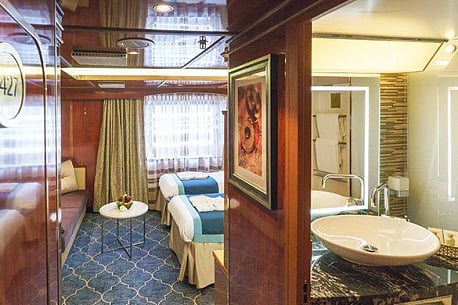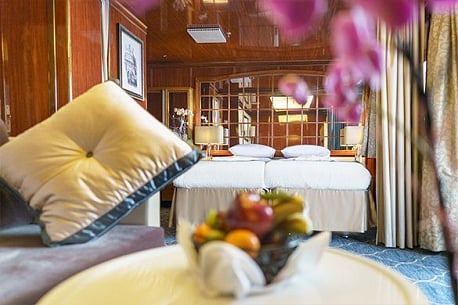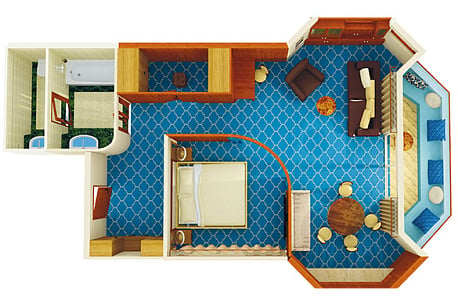.png)
Svalbard Circumnavigation and Kvitøya
In-Depth Exploration in the Land of the Polar Bear
SUPER EARLY BIRD SAVINGS
UP TO 20% OFF*
17 Jul - 30 Jul 2025
14 days
13 days


| Dates | days | Activities | Special Offers | Rates from | |
|---|---|---|---|---|---|
|
In-Depth Exploration in the Land of the Polar Bear 15 Jul - 28 Jul 2024 |
14 |


|
US$ 10 695 per person |
Request a quote | |
|
In-Depth Exploration in the Land of the Polar Bear 5 Jul - 18 Jul 2025 |
14 |


|
SUPER EARLY BIRD SAVINGS |
US$ 10 495
US$ 8 921 per person |
Request a quote |
|
Historical Expedition Cruise "In the Footsteps of Aviation Pioneers" 29 Jul - 11 Aug 2025 |
14 |


|
GERMAN LANGUAGE ONLY |
US$ 10 595
US$ 9 006 per person |
Request a quote |
VIDEO
Itinerary

Welcome to Longyearbyen, the administrative center of Svalbard and starting point of our Arctic expedition! At the Longyearbyen airport, you will be greeted by our staff and transferred to a quality hotel, which has been arranged by us and is included in the price of the itinerary. You will then be free to explore the charming, walkable town center.
We recommend starting your discovery of this fascinating Norwegian High Arctic territory at the excellent Svalbard Museum, where you can also purchase hard-to-find polar books and maps. Afterward, you can enjoy an excellent dinner at one of Longyearbyen’s many delightful restaurants. If you are still awake at midnight, you will notice the sun has not set. In fact, the sun will not set for the entire duration of our time in Svalbard.

After breakfast at your hotel, the morning is yours to enjoy Longyearbyen. Take in the views of icy fjords and glaciated mountains surrounding this historic former coal-mining town. Take advantage of shopping for souvenirs or some last-minute necessities such as cold-weather gear. Just remember, you will soon receive your very own parka to keep and waterproof boots to borrow on board the ship. For lunch, Longyearbyen offers quick and easy meal options including the most northerly pizzas and kebabs in the world.
In the afternoon, you will be transferred to the pier where we will warmly welcome you aboard the deluxe expedition vessel M/V Sea Spirit. Get settled in your spacious suite and explore the ship that will be your comfortable home during the extraordinary adventure to come. After getting underway, a full schedule of events kicks off with informative briefings and introductions from your expedition staff. After the first of many delicious dinners on board, step out onto the open decks to admire the gorgeous scenery in 24-hour daylight as we pass through the wildlife-rich waters of Isfjorden.

.jpg)


.jpg)
The goal of this voyage is a circumnavigation of the Svalbard archipelago. We will make an attempt to go to the northeastern most part of the archipelago – the island of Kvitøya, famous for its polar bears. Along the way, we hope to experience the many facets of this incredible High Arctic territory.
Much of the pristine nature of Spitsbergen is protected by a system of national parks, and the first one on our way will be the Northwest Spitsbergen National Park, which is the crown jewel of Svalbard’s scenic wonders. This area is well-known for its deep fjords flanked by serrated mountain ranges and immense tidewater glaciers calving icebergs into turquoise waters. The skies are filled with millions of murres, guillemots and little auks, whose eggs are just now hatching at countless breeding colonies located on small islands, mountainsides and sea cliffs within the park. This is also a great chance to encounter marine mammals, including beluga whales and various Arctic seals.
This wildly beautiful area contains many enchanting locations like Signehamna Bay and Kongsbreen Glacier (“Kings Glacier”). Human habitation – rare along our route – can be found at Ny Ålesund, a former mining town and airship base that is now home to an international community of Arctic researchers. This is one of the world’s most northerly settlements where you can find a museum, gift shop and post office.

The Svalbard Archipelago is located halfway between the top of Norway and the North Pole, which means the Polar Ice Edge can be found to the north of the islands! This corner of Svalbard is full of stunning scenery and wildlife as well as rich history from the age of exploration. Our plan is to navigate along the ice edge towards the island of Nordaustlandet and further to the east towards Kvitøya (White Island). However, remember, our route and research opportunities are heavily dependent on the weather. But rest assured, we’ll take the best possible advantage of the circumstances presented to us by nature in this wild and remote corner of the world.

.jpg)
On this part of the journey, we will make an attempt to go to the eastern and northern regions of the Svalbard Archipelago – infrequently visited aboard expedition ships – experiencing the isolation and beautiful remoteness of Svalbard’s Arctic wilderness areas. Kvitøya (White Island) is one of the most rarely visited and closest islands to Franz Josef Land. This place, almost completely covered by ice, became the final resting place of the balloon expedition of the Swedish polar explorer Salomon August Andrée. Kvitøya is not always accessible to expedition ships, but it may provide another opportunity to observe polar bears in their natural habitat.

.jpg)
.jpg)

During this voyage, we expect to encounter significant sea ice concentrations in the enormous Northwest Svalbard Nature Reserve, which covers the rugged northwestern parts of Spitsbergen and the entirety of Nordaustlandet, the second largest island in Svalbard. In this remote and isolated region, ice can persist very late into the summer. The massive Austfonna ice cap rises above the stunning landscapes of the High Arctic. Part of it meets the sea along the 45-kilometer ice cliff known as Bråsvellbreen—one of the great wonders of the Arctic world. The polar desert environment supports little in the way of vegetation, but hosts a prodigious number of seabirds. The cliffs of Alkefjellet are home to thousands of pink-footed geese, glaucous gulls, little auks, black-guillemots, snow buntings and (probably) barnacle geese. Historically, this icy wilderness has proven a good location for spotting polar bear and walrus.


.jpg)
.jpg)
The Southeast Svalbard Nature Reserve is a truly pristine and rarely visited wilderness containing hundreds of uninhabited islands. On the large islands of Edgeøya and Barentsøya, broad tundra valleys support the territory’s densest population of endemic Svalbard reindeer. The valleys are also important breeding areas for ground-nesting birds such as geese, eiders and sandpipers. Arctic foxes prowl the vast landscape, seeking to provide food for their young cubs, who are just now emerging from their dens. Shallow, murky seas are ideal feeding grounds for walruses resting in large numbers on gently sloping beaches. Historical sites throughout the islands provide glimpses into the region’s bygone era of trapping and hunting.
South Spitsbergen National Park is a vast region of varied landscapes, including polar deserts and impassible mountain ranges. The centerpiece of this park is Hornsund, a picture-perfect fjord where countless mighty glaciers cascade from soaring mountaintops into icy inlets. The park also includes the southern shores of Bellsund, a picturesque bay where the remains of historical whaling operations can be found, including wooden boats, cabins and thousands of whale bones — a scene from the distant past, literally frozen in time. Throughout the park, there is always a high probability of wildlife sightings. Wildflowers will be at their peak during this time.
Because of its extended length, this ambitious and in-depth Svalbard circumnavigation expedition cruise is a great chance to get a comprehensive view of the Arctic’s many faces. Every day offers something new and exciting. We will not miss a single opportunity to encounter amazing Arctic wildlife, witness incredible polar scenery and walk in the footsteps of historic expeditions

Our circumnavigation of the Svalbard archipelago is coming to an end. We are back to the West Coast of the Spitsbergen archipelago, with its beautiful locations like Alkhornet Mountain (which is also known as bird heaven because its cliffs support over 10,000 breeding pairs of seabirds).

After filling up with one last buffet breakfast on board, we bid you farewell in Longyearbyen. We provide transfers to the airport or to the town center in case you plan to stay longer in Svalbard. By this time, you may already be making plans for your next amazing trip with us into the polar worlds!
Itinerary, landings and all other activities during the cruise depend strongly on ice and weather conditions and are subject to the decisions of the Expedition Leader and the Captain of the vessel. Encounters with any mentioned wildlife cannot be guaranteed.
Rates
| Triple Suite |
US$ 8 921
US$ 10 495 |
request Book online | ||||||||||




|
||||||||||||
| Main Deck Suite |
US$ 12 321
US$ 14 495 |
request Book online | ||||||||||




|
||||||||||||
| Single Suite |
US$ 18 356
US$ 21 595 |
request Book online | ||||||||||






|
||||||||||||
| Classic Suite |
US$ 13 086
US$ 15 395 |
request Book online | ||||||||||





|
||||||||||||
| Superior Suite |
US$ 12 556
US$ 15 695 |
request Book online | ||||||||||




|
||||||||||||
| Deluxe Suite |
US$ 14 156
US$ 17 695 |
request Book online | ||||||||||




|
||||||||||||
| Premium Suite |
US$ 15 436
US$ 19 295 |
request Book online | ||||||||||





|
||||||||||||
| Owners Suite |
US$ 19 836
US$ 24 795 |
request Book online | ||||||||||






|
||||||||||||
* Super Early Bird discount (15% off on Triple, Main Deck, Single, and Classic Suites; 20% off on Superior, Deluxe, Premium, and Owner’s Suites) is available for new bookings confirmed by June 30, 2024.
Cruise rates are quoted per person. Sharing is available in Triple, Main Deck, Classic, and Superior Suites. If you prefer a cabin for yourself, the following categories are available with the single supplement: x1.7 for Main Deck, Classic, and Superior Suites; x2 for Deluxe, Premium, and Owner's Suite.
Rates Include:
- 1 pre-voyage night on Day 1 in a hotel in Longyearbyen;
- Group transfer to the ship for embarkation on Day 2;
- Group transfer upon disembarkation;
- Shipboard accommodation;
- Group transfer from the airport to the hotel on Day 1;
- All meals on board throughout the voyage;
- AECO fees and governmental taxes.
- Tea and coffee station 24 hours daily;
- All scheduled landings/excursions (subject to weather and ice conditions);
- Leadership throughout the voyage by our experienced Expedition Leader & Expedition Team;
- Branded Poseidon Expeditions parka;
- Rubber boots for shore landings for the time of the cruise;
- Welcome and Farewell cocktails;
- All port fees;
- Pre-departure materials;
- Digital Voyage Log;
- Wi-Fi on board.
Rates Do Not Include:
- Airfare;
- Visa and passport fees (if applicable);
- Fuel surcharge may be applied for all bookings;
- Luggage and trip cancellation insurance;
- Soft drinks and alcoholic beverages other than those for special events and celebrations;
- Personal expenses such as laundry and telecommunication charges;
- Mandatory Emergency Evacuation Insurance to a minimum benefit of US$ 200,000 per person;
- Kayaking;
- Staff gratuities.
Adventure options

Kayaking fee $795 - A$1200 - £650
We are pleased to offer our sea kayaking option along the coastal waters of Ireland, Wales and Scotland! Experience some fascinating bird cliffs and unusual geological structures against a backdrop of ethereal verdant slopes, all from our sturdy and stealthy sea kayaks. Join us for an unscripted adventure as we explore rugged coastlines and remote coves in which few people have ever paddled.

Free option
The Polar Regions are perhaps the most photogenic on earth, with countless beautiful scenes presenting themselves every day. Endless expanses of ice, beaches crowded with seals or penguins, sunsets over unbroken horizons, starlit skies, and even the majestic northern lights – they all present fantastic photographic opportunities – and in order to make sure that you come home with some spectacular images we offer you the chance to learn and practice your photography alongside an experienced professional.
Our expert Photographer will be on hand to answer your questions and give advice, both in the form of on-board lectures and workshops on shore. Explore the key elements of photography in a fun and relaxed setting, with plenty of opportunities for questions and feedback. Learn how to see light in a new way and experiment with the techniques of composition and framing.
request a quote
Cabin:
Date:
Duration:
Articles

Pomors – Pioneers of Arctic Exploration
Nowadays people travel in the Arctic aboard massive icebreakers with reinforced hulls. But it wasn’t...

Growing threat for polar bears
Polar bears are, at least in their image in the popular imagination, among the cutest, cuddliest...

Global warming: for good or ill
The concept of global warming, or climate change, has become a point of contention among scientists,...

Did you know that…?
The area of the Arctic is almost 3 times the size of Europe and is about 27 million km². For a long...









